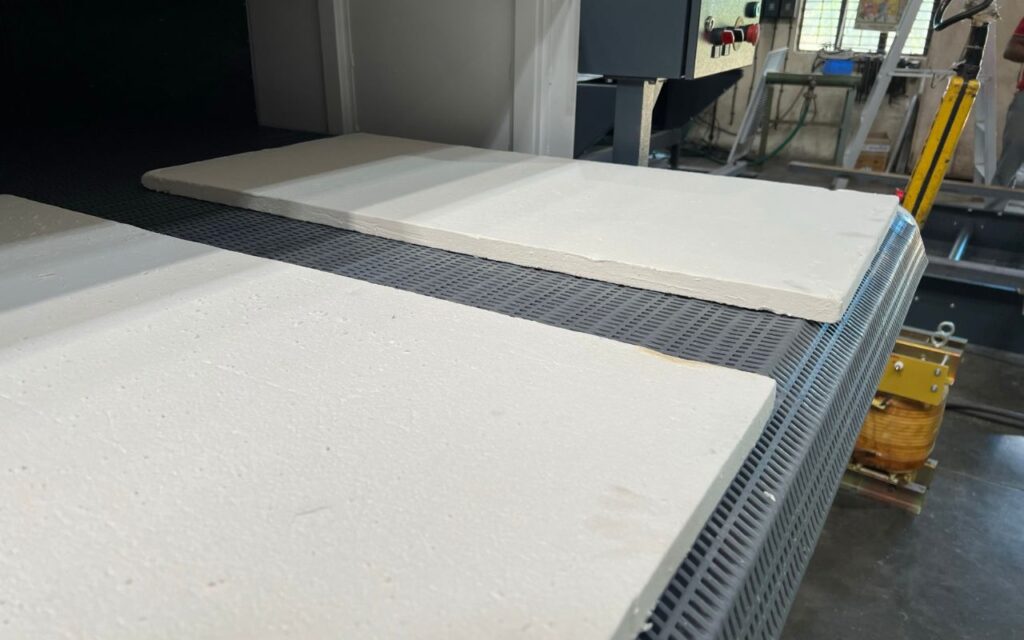Radio Frequency (RF) Drying: A Revolution in Ceramics and Fiberglass
Since the 1940s, RF drying has played a role in the processing of ceramics and fiberglass. This technology is used to dry ceramic products like filters, catalytic converter substrates, ceramic fiber mats and boards, and insulation, as well as fiberglass strands and rovings in RF ovens.
The Challenges of Drying Ceramics and Fiberglass
Drying these materials poses several challenges, with one of the most problematic being the uneven drying of materials with low thermal conductivity (such as ceramics and fiberglass.) Traditional drying methods heat materials from the outside in, which is particularly time-consuming for thermal insulators. This can result in thermal stresses, cracking in ceramics, and binder, sizing and solids migration in fiberglass. Conventional methods often involve prolonged drying times, leading to low throughput, high costs, and extended inventory lead times.
RF drying offers a solution by heating the entire volume of the product uniformly, significantly reducing drying times and improving product quality. For example, some ceramics can dry in just 30 minutes instead of 12 hours, and certain fiberglass packages can dry in 90 minutes instead of 24 hours.[1]
The Challenges of Drying Ceramics and Fiberglass
Traditional batch drying ovens can be labour-intensive and inefficient. RF ovens, with their continuous conveyor systems, allow products to move through the oven seamlessly, reducing gaps in production and enhancing energy efficiency. RF energy specifically heats the water(and other materials with a non insignificant dielectric loss factor) in the product, minimising wasted heat and focusing energy use on water removal

RF Mechanism
The RF heating mechanism is based on the dielectric properties of the material being processed. Dielectric properties are the electrical properties of the material that determine how well it interacts with electromagnetic energy. Materials with a high dielectric loss factor, such as water and many organic materials, are particularly suitable for RF heating and drying. When RF energy is applied to the material, the oscillating electric field causes the molecules in the material to constantly re-align with the field. This re-alignment generates heat due to molecular friction.
Water and organic materials interact well with RF energy because they have high dielectric loss properties. This is because water and organic materials have polar molecules, meaning they have a positive and negative end. When the electric field of the RF energy is applied to these materials, it causes the molecules to rotate rapidly, which generates heat due to molecular friction. This frictional heat causes the material to heat up and dry.
Put simply, Dielectric loss is the measure of the ability of a material to convert the energy of an electromagnetic field into heat.
RF Drying Mechanism
RF drying works by heating the material and evaporating the moisture within it. As the material heats up, the moisture within it begins to evaporate, and the vapour is removed by an air flow. The process can be accelerated by creating a vacuum or by reducing the relative humidity of the air flow. The rate of drying depends on several factors, such as the moisture content of the material, the temperature, and the airflow.
RF Drying Mechanism
Strayfield’s RF drying processes utilise a warm air circulation system to remove water vapour, preventing condensation inside the oven and recondensation on the product once steam is produced
Water Vapour transport mechanism
Strayfield’s RF drying processes utilise a warm air circulation system to remove water vapour, preventing condensation inside the oven and recondensation on the product once steam is produced
Demonstrated Success in Industry
RF drying technology has proven successful in the ceramics and fiberglass industries, offering benefits such as reduced drying times, increased line speeds, efficient space usage, and compatibility with lean manufacturing processes. RF dryers integrate easily into production lines, with minimal warm-up and cool-down times. The technology provides uniform heating, reducing thermal stresses and preventing overheating, which can lead to unwanted chemical reactions.
Case Study: Transformational Fibre Glass RF Drying Solution for Valmieras Stikla Skiedra
References:
[1] Radio Frequency Drying of Ceramics and Fiberglass: http://www.ceramicindustry.com/articles/94541-radio-frequency-drying-of-ceramics-and-fiberglass/
